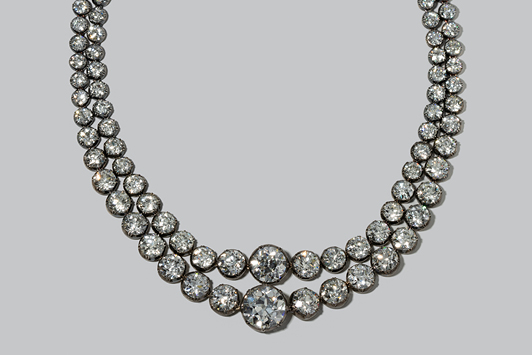 Image: Windsor Jewelers
Image: Windsor Jewelers
Dealers all use the same word when describing the current estate jewelry market: It’s hot. Very hot. The numbers tell the same story: A September 2020 report by Boston Consulting Group pegged the secondary market for hard luxury items (watches and jewelry) at around $21 billion. It also forecast growth of 8% per year through 2023 — seven times more than the projected rise of the primary market.
Indeed, the vintage jewelry market is stronger than it’s ever been, says Paul Lubetsky, founder of Windsor Jewelers in New York, which boasts an inventory of over 15,000 pieces. He attributes the enthusiasm to the rarity of the merchandise: “A lot of people are showing a renewed interest in buying estate jewelry — Victorian, Deco, Retro — because each piece is unique, which makes it more desirable for people.”
Compared to the offerings at most mainstream jewelry stores, where one-of-a-kind items are harder to come by, estate jewelry has a strong appeal, he adds.
Still, the estate market has a growing list of challenges for the dealers who have made it their business.
Raising their standards
Collectors have become more demanding, observes Steven Fearnley, owner of jeweler J.S. Fearnley in Atlanta, Georgia. Middle-market items are losing favor as clients become more accustomed to — and therefore bored of — these pieces.
“I’m having to look for finer-quality gemstones and more interesting signed pieces to keep the interest of the clients,” Fearnley shares. The internet, which has enabled potential collectors to access a wider range of jewelry, has also made them more selective.
“When Covid-19 happened, so many people went to the internet for shopping. And I think the commonplace was so visible. [Customers] could see certain things over and over again, and they didn’t want that. They wanted something that wasn’t so common. And so I think people’s tastes started leaning toward something special,” elaborates Fearnley.
The estate dealer, who started his career in 1986, has also “given up” on some of the most ubiquitous pieces on the secondary market, including the Cartier Love bracelet and the Van Cleef & Arpels Alhambra necklace. “There are too many fakes out there. There are too many pieces selling at retail price or above online. Trying to buy something at a fair price to then turn it to another person at a fair price has just become impossible.”
Playing hard to get
The biggest challenge for estate dealers is trying to replace what they’ve sold. The sector is experiencing a shortage of supply — due largely to the rare nature of the items. Covid-19 made things even harder for international dealers by leaving them unable to travel.
“It’s quite difficult to buy the goods if you don’t see them,” says Switzerland-based Ronny Totah, cofounder of jeweler Horovitz & Totah and of the GemGenève show. “But once you have the proper goods, the selling becomes really much easier.”
Totah has seen how digital channels are increasing consumer awareness of estate jewelry — though by his own admission, he prefers to do business face-to-face rather than online.
Meanwhile, these consumers — whether veteran connoisseurs or newcomers — are now competing against dealers in an arena that formerly belonged to the latter: the auction circuit.
“Auctions are getting harder and harder to buy from,” says Fearnley. “They used to be a pretty good source for me, but now it’s quite tricky because of the change in the market. If they have a great David Webb piece, that’s hard to buy, because it’s not just me and other dealers fighting for it, it’s me and the dealers and the rest of the world fighting for it.”
Article from the Rapaport Magazine - December 2021. To subscribe click here.